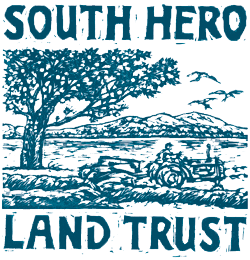Filling their Plates with a “Fresh Rainbow” from the Folsom Food Forest
Summer 2023 Newsletter
This May, SHLT staff met local 3rd and 4th grade students in the Folsom Learning Garden and finally let them do the one thing they always ask to do: get some shovels and dig a bunch of holes. While fun is always a goal in the garden, we dug these holes for good reason: to assess the soil in different parts of the garden and determine the best spot for the Folsom Food Forest.
Last winter, SHLT staff worked with Folsom teachers Dani Holm and Megan Branon to apply for the Vermont Garden Network’s Fruit and Nut Tree Grant.
“Over the past few years our collaborative work with the SHLT has empowered the 3rd and 4th graders to take on leadership roles in Folsom’s Learning Garden. The interdisciplinary nature of working in the garden has allowed students’ learning to come to life. Students are able to witness first hand, the cyclical patterns of seasons, plants, and animals that we speak so much of in science class. They seamlessly integrate their math skills as they calculate spacing for native plants. They consider the history of the land on which they’ve been called to steward and pour over research to determine which plants will thrive best. These students are already thick as thieves with this little diversified slice of land so being deeply involved in the design and implementation of expanding the gardens to include a food forest has been very exciting work for all of us.”
- Dani Holm, Folsom 3rd/4th teacher
We envisioned a collaborative project in which students would be involved in the creation of a multi-level edible landscape in the garden, complete with dwarf fruit trees, berry bushes, grape vines, a shady seating area, and strawberries underneath - in other words, a food forest! We were thrilled to be awarded the grant by the Vermont Garden Network, and soon got to work preparing for the spring project.
After assessing the site conditions, students worked in groups to select species to plant, decide where they should go in the garden, think about how to keep them safe from deer, and perhaps most importantly, what should happen to the (literal) fruits of their labor! Then the groups presented their plans, debated the various aspects of each, and voted on their favorite elements to create an overall plan for the site.
Finally, the students joined us for two work parties in the garden, to “dig a bunch of holes” and plant the berry bushes, vines, and fruit trees. We can’t wait to see how their forest grows!
